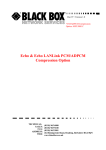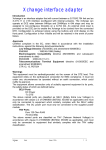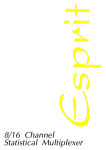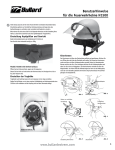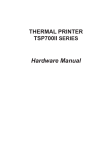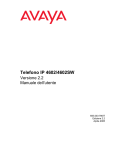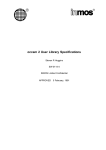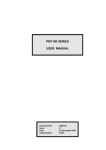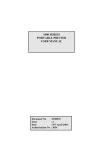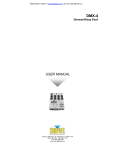Download G-Converter Chassis
Transcript
G-Converter Chassis: RMU200 230VAC Power Supply: PSU200-230 48VDC Power Supply: PSU200-DC SNMP Management Card: MTU200C-SNMP Rev 3.6 G-Converter Chassis TECHNICAL: SALES: FAX: ADDRESS: WEB: (0118) 965 6000 (0118) 965 5100 (0118) 965 5001 464 Basingstoke Road, Reading, Berkshire RG2 0QN www.blackbox.co.uk G-Converter Chassis How To Contact your Local Black Box Italy: Australia: Black Box Italia S.P.A Black Box Catalog Australia PTY LTD Tel: 0227400280 Fax: 0227400219 Web Site: www.blackbox.it Tel: 0398797100 Fax: 0398702955 Deutschland: Brazil: Black Box Deutschland Black Box Do Brasil. Tel: 0811/5541-0 Fax: 0811/5541-499 Web Site: www.blackbox-deutschland.com Tel: (011) 5515-4000 Fax: (011) 5515-4002 Web Site: www.blackbox.com.br Switzerland: Canada: Datacom Black Box Services AG Black Box Canada Corp. Tel: 0554517070 Fax: 0554517075 Web Site: www.black-box.ch Tel: 0416-736-8000 Fax: 0416-736-7348 Web Site: www.blackbox.com Netherlands: Mexico: Black Box Datacom BV Black Box De Mexico S.A. de C.V Tel: 03032417799 Fax: 0302414746 Web Site: www.blackbox.nl/ Tel: 05-420-0100 Fax: 05-420-0123 Web Site: www.blackbox.com.mx Belgium: Japan: Black Box Black Box Catalog Tel: 027258550 Fax: 027259212 Web Site: www.blackbox.be Tel: 03-3820-5011 Fax: 03-3820-5010 Web Site: www.blackbox.co.jp/ 2 SALES: 0118 965 5100 G-Converter Chassis France: U.S.A Black Box Catalogue Black Box Corporation Tel: 0145606700 Fax: 0145606747 Web Site: www.blackbox.fr Tel: 724-746-5500 Fax: 724-746-0746 Web Site: www.blackbox.com Spain: Chile Black Box Comunicaciones S.A. Black Box Chile Tel: 34 91 663 0200 Fax: 34 91 661 84 35 Web Site: www.blackbox.es Tel: 00 562 223 8811 Fax: 00 562 225 1002 Web Site: www.Blackbox.cl TECHNICAL: 0118 931 2233 3 G-Converter Chassis Contents Contents...................................................................................................................... 4 Introduction................................................................................................................. 7 Overview........................................................................................................... 7 Manager Card................................................................................................... 8 Manager Card LED Indication.......................................................................... 9 Removal of Manager Card............................................................................... 9 Power Supplies................................................................................................. 9 Installation................................................................................................................. 10 Before installation, refer to the safety warnings, approvals requirements and emc requirements in the appendices.......................................................... 10 Environmental Considerations........................................................................ 10 Card Cage System......................................................................................... 10 Manager Card................................................................................................. 10 Power Supplies............................................................................................... 10 Channel Cards................................................................................................ 10 Management – Overview.......................................................................................... 11 Supervisor Port (terminal management)................................................................... 12 Supervisor Terminal Requirements................................................................ 12 Supervisor Terminal Emulation...................................................................... 12 General set-up Display Layout....................................................................... 13 General Keyboard Conventions..................................................................... 14 Cursor Movement........................................................................................... 14 Parameter Changing...................................................................................... 14 Accepting all changes and Updating the Configuration.................................. 14 Abandoning Changes..................................................................................... 15 Changing the Configuration Page.................................................................. 15 Restoring the Factory Default Configuration .................................................. 15 10 Base-T Port (Telnet Management)....................................................................... 16 System Name................................................................................................. 16 Location.......................................................................................................... 16 IP Address...................................................................................................... 16 Subnet Mask................................................................................................... 16 Gateway......................................................................................................... 16 Supervisor Terminal Requirements................................................................ 17 Supervisor Terminal Emulation...................................................................... 17 General set-up Display Layout....................................................................... 18 General Keyboard Conventions..................................................................... 19 Cursor Movement........................................................................................... 19 Parameter Changing...................................................................................... 19 Accepting all changes and Updating the Configuration.................................. 19 Abandoning Changes..................................................................................... 20 Changing the Configuration Page.................................................................. 20 Restoring the Factory Default Configuration................................................... 20 Telnet Screen................................................................................................. 20 Ethernet Screen.............................................................................................. 21 IP Screen........................................................................................................ 22 Alarms Screen................................................................................................ 23 4 SALES: 0118 965 5100 G-Converter Chassis Events Screen................................................................................................ 24 SNMP Management.................................................................................................. 25 System name.................................................................................................. 25 Location.......................................................................................................... 25 IP Address...................................................................................................... 25 IP Address...................................................................................................... 25 Gateway......................................................................................................... 25 Supervisor Terminal Requirements................................................................ 25 Supervisor Terminal Emulation...................................................................... 26 General set-up Display Layout....................................................................... 26 Typical Configuration Display......................................................................... 27 General Keyboard Conventions..................................................................... 28 Cursor Movement........................................................................................... 28 Parameter Changing...................................................................................... 28 Accepting all changes and Updating the Configuration.................................. 28 Abandoning Changes..................................................................................... 29 Changing the Configuration Page.................................................................. 29 Restoring the Factory Default Configuration................................................... 29 Diagnostics................................................................................................................ 30 Manager Card................................................................................................. 30 Power Supply ................................................................................................ 30 Fan Assembly................................................................................................. 30 SNMP Traps................................................................................................... 30 Appendix A- Warnings............................................................................................... 31 00000000.................................................................................................................. 31 Appendix B –Approval Requirements....................................................................... 33 Appendix C - EMC Requirements............................................................................. 34 TECHNICAL: 0118 931 2233 5 G-Converter Chassis G-Converter System’s Chassis User Manual WARNING - BEFORE INSTALLATION, PLEASE REFER TO SAFETY INSTRUCTIONS IN APPENDIX A, AND EMC INSTRUCTIONS IN APPENDIX C Certified Compliant in the EC, when fitted with G.703/704 to X.21 interface/rate converter Data Channel cards, and in accordance with the installation instructions. Low Voltage Directive (73/23/EEC and amendment 93/68/EEC) EN60950 : 1992 (Safety) Electromagnetic Compatibility directive (89/336/EEC and subsequent amendments to date): EN55022 EN50024 : 1994 (Emissions) : 1998 (Immunity) Telecommunications Terminal Equipment directive (91/263/EEC and amendment 93/68/EEC) where indicated in approvals requirements section. 6 SALES: 0118 965 5100 G-Converter Chassis Introduction This manual provides information covering installation and set-up procedures of the GConverter Card Cage System. Accommodation within the Card Cage System is provided for up to 18 Channel Cards; 1 Manager Card; and 2 Power Supplies. All cards may be ‘hot swapped’. The Card Cage System is normally supplied with a single 40W 230V AC Power Supply Module. Additional Power Supply Modules can be supplied to meet specific requirements. Overview The Card Cage System, manufactured from extruded aluminium, comprises 21 slots, within a 19-inch, 3U enclosure. A PCB back plane, which provides interconnection between the front and rear sections of the Channel cards, is located towards the back of the enclosure. Channel connection is achieved by simply plugging the appropriate front and rear sections into the back plane. TECHNICAL: 0118 931 2233 7 G-Converter Chassis Manager Card The Manager Card is a single section card that plugs into Slot 19 of the Card Cage System. This card provides the facilities for setting up and controlling all types of Data Channel Cards, additionally it is used to log and report faults on the Channel Cards, Power Supplies and Cooling Fan. Both a 10 Base-T Ethernet port and an RS232 Supervisor port are provided. Access to these ports is via the fixed rear panel of the Card Cage System. The Manager Card is essential for controlling most types of Data Channel Cards, exceptions being the G-Converter 2.048Mbps and the G-Converter Nx64k. 8 SALES: 0118 965 5100 G-Converter Chassis The Nx64 Channel Cards are universal and may be operated with/or without a Manager Card. Rotary switches, recessed into the front panel, permit selection of the data rate in [N x 64k increments]. The selected N rate is simultaneously confirmed via the numeric display. The 2.048Mbps Channel Cards have no set up or alarm features negating the need for the Manager Card. Manager Card LED Indication On the front of the Manager Card are five LEDs. In order, from top to bottom, they are:LED name Manager Card operational Ethernet activity PSU 1 operational PSU 2 operational Fan operational Function Red = faulty, green =ok Amber = TX and RX, green = link active, Off = no link Red = faulty, green =ok Red = faulty, green =ok Red = faulty, green =ok Removal of Manager Card The Manager Card can only be fitted in slot 19. The Manager Card can be ‘hot swapped’ by simply releasing the retaining screws on the top and bottom of the Manager Panel and with the aid of the injector/ejector handles withdraw the card. Simply reverse this process to install the card. N.B if the Data Channel Cards were powered during the swapping of a Manager Card then the new Manager Card will interrogate the data channel cards for set up parameters and store these in its non volatile memory. Power Supplies The Card Cage provides accommodation for up to two Euro-cassette types, 40 watt, Power Supply Modules. Typically, a single Power Supply will be fitted; adding a second Power Supply reduces the probability of power failure. The Power Supplies are connected to individually fused and filtered IEC inlets; each module is capable of powering the fully populated Card Cage. If two modules are installed loading is shared between them. In the event of one of the modules failing the other will supply the complete Power requirement of the Card Cage. TECHNICAL: 0118 931 2233 9 G-Converter Chassis Installation Before installation, refer to the safety warnings, approvals requirements and emc requirements in the appendices. Environmental Considerations The equipment must be operated under the following atmospheric conditions: Temperature: Humidity: 0 to 40 degrees centigrade. 0% to 90% non-condensing. Card Cage System The Card Cage System should be housed in a cabinet that is considered by EN60950 to be a suitable electrical and fire enclosure. Refer to Appendix A for safety warnings. A fixing flange is fitted to the front of the Card Cage to mount the unit into the cabinet. Manager Card Note: THE MANAGER CARD MUST ONLY BE PLUGGED INTO SLOT 19. The Manager Card is connected to the 9 Way-D Supervisor Port, and the RJ45 10Base-T port, located adjacent to the fan on the rear of the Card Cage. Connection between individual Channel Cards and the Manager Card is achieved via the back plane (See Figures 1 and 2). There are no user configurable links on the Manager Card. Power Supplies The Power Supplies are installed in Slots 20 and 21. Slot 21 is located on the extreme right hand side of the Card Cage, when viewing it from the front, (See Figure 1). Mains power for Slots 20 and 21 is provided by a pair of IEC connectors, the upper connector is allocated for Slot 21, the lower connector for Slot 20. When only one Power Supply is fitted it should be into Slot 21 with mains power being supplied via the upper IEC connector. A blanking panel should be installed to cover Slot 20. Channel Cards Channel Cards for the Card Cage may be selected to meet several requirements; the cards are fitted into slots 1 to 18. The cards can be ‘hot swapped’ by simply releasing the retaining screws on the top and bottom of the panel and with the aid of the injector/ejector handles carefully withdrawing the card. Simply reverse this process to install a card. 10 SALES: 0118 965 5100 G-Converter Chassis Management – Overview This manual deals with the set-up configurations specific to the Card Cage assembly. Configuration of the various Channel Cards available is detailed in a separate manual. A choice of three methods is available to manage the Channel Cards: Terminal Management via the Supervisor Port, Telnet and SNMP. TECHNICAL: 0118 931 2233 11 G-Converter Chassis Supervisor Port (terminal management) This RS232 option is presented on a female 9 Way-D connector. It can support VT52, VT100, ADDSVP, ADM3A, H1500, N8009, and TVI920 terminal emulation modes. Selection of the required option is made on the power up screen. Supervisor Terminal Requirements The terminal should be configured as follows: 8 bits per character, no parity, one stop bit, speed 19.2 Kbps. A ‘modem’ or ‘straight’ serial cable is suitable for connection of the Supervisor port (the Supervisor port pin-out out is described in Appendix C). Supervisor Terminal Emulation The Manager Card supports several terminal emulations. When connection is made between the terminal and the RS232 Supervisor port, the following screen will appear: Please select terminal type from the following: 1 = VT52 2 = VT100 3 = ADDSVP 4 = ADM3A 5 = H1500 6 = N8009 7 = TVI920 The terminal type or emulation in use should be selected by pressing the relevant number key on the PC or terminal. The terminal will then show the basic configuration screen for the chassis’s set-up. You may return to this screen at any time by pressing ‘CTRL’ and ‘E’ at the same time. 12 SALES: 0118 965 5100 G-Converter Chassis General set-up Display Layout There are three main areas on the Supervisor set-up screen used to change parameters for the Card Cage System: Upper left – System parameters Upper right – Other display pages which may be selected. Bottom – Configuration. Typical Configuration Display Figure 3 TECHNICAL: 0118 931 2233 13 G-Converter Chassis General Keyboard Conventions Only a few keys are required to configure the chassis and are summarised as follows: → (Right arrow) Moves the cursor to the next field to the right. ← (Left arrow) Moves the cursor to the next field to the left. ↑ (Up arrow) Moves the cursor to the next field upwards. ↓ (Down arrow) Moves the cursor to the next field downwards. + (Plus) or <SPACEBAR> Toggles the parameter value up to the next available setting. − (Minus) Toggles the parameter value down to the next available setting. <ENTER> or <RETURN> Accepts the current display page (otherwise the same as ↓). <CTRL> and U Updates all changes. <ESC> Abandons all changes since the last <CTRL> U. <CTRL> and P Refresh screen. Cursor Movement The cursor symbol “>” is moved around the screen to the required field using the arrow keys. Parameter Changing If it is possible to modify the field over which the cursor is placed, an appropriate message is shown at the bottom of the screen. No message will appear if the field is non-configurable. Pressing the Space bar, the “+” key or the “-“ key will cycle through the choices available for a parameter. Accepting all changes and Updating the Configuration If “Control” and “U” are pressed at the same time after the configuration has been altered, the configuration is updated at the local and remote end as necessary and held in non-volatile Memory. 14 SALES: 0118 965 5100 G-Converter Chassis Abandoning Changes Pressing ESC at any point before a configuration is updated will cause the message “Abandon Changes? (y/n)” to appear at the bottom of the screen. If “n” is selected, the message will disappear and editing may continue. If “y” is pressed, all modifications will be abandoned and the last updated configuration will be re-printed on the screen. Changing the Configuration Page The Configuration Page required, e.g. “Alarms”, is selected by moving the cursor to the upper right area and pressing Enter when alongside the required page. The currently selected page is indicated by a ‘*’. Restoring the Factory Default Configuration The system may be reset to the factory default configuration by pressing CTRL-R four times when the cursor is on the Terminal emulation page (see page 12). A ‘Confirm’ message will be displayed before the configuration is reset. The previous configuration will be lost. TECHNICAL: 0118 931 2233 15 G-Converter Chassis 10 Base-T Port (Telnet Management) This method uses the 10 Base-T RJ45 (Ethernet) port. When a Telnet compatible PC is connected to this port a management platform identical to that available via the Supervisor Port is supported. Before Telnet or SNMP management is used, it is essential that the notes relating to Supervisor Port Management be studied. (See pages12-15). To enable SNMP or Telnet management, information must be added to the Manager Card via the Supervisor Port. The user must first set up various parameters namely IP address, Subnet Mask and Gateway. The information required is: System Name A text field to identify the system. May be up to 32 characters. Location A text field to identify the location of the system. May be up to 32 characters. IP Address The IP address of the system. This must be set from the supervisor port to enable SNMP or Telnet access. Subnet Mask The Subnet mask of the local network. This must be set from the supervisor port before SNMP and Telnet access is required. Gateway The IP address of the default gateway from the local network. To assist the process of adding this information, the relating to Supervisor port management is detailed below. 16 SALES: 0118 965 5100 G-Converter Chassis Supervisor Terminal Requirements The terminal should be configured as follows: 8 bits per character, no parity, one stop bit, speed 19.2 Kbps. A ‘modem’ or ‘straight’ serial cable is suitable for connection of the Supervisor port (the Supervisor port pin-out out is described in Appendix C). Supervisor Terminal Emulation The Manager Card supports several terminal emulations. When connection is made between the terminal and the RS232 Supervisor port, the following screen will appear: Please select terminal type from the following: 1 = VT52 2 = VT100 3 = ADDSVP 4 = ADM3A 5 = H1500 6 = N8009 7 = TVI920 The terminal type or emulation in use should be selected by pressing the relevant number key on the PC or terminal. The terminal will then show the basic configuration screen for the chassis’s set-up. You may return to this screen at any time by pressing ‘CTRL’ and ‘E’ at the same time. TECHNICAL: 0118 931 2233 17 G-Converter Chassis General set-up Display Layout There are three main areas on the Supervisor set-up screen used to change parameters for the Card Cage System: Upper left – System parameters Upper right – Other display pages which may be selected. Bottom – Configuration. Typical Configuration Display Figure 4 18 SALES: 0118 965 5100 G-Converter Chassis General Keyboard Conventions Only a few keys are required to configure the chassis and are summarised as follows: → (Right arrow) Moves the cursor to the next field to the right. ← (Left arrow) Moves the cursor to the next field to the left. ↑ (Up arrow) Moves the cursor to the next field upwards. ↓ (Down arrow) Moves the cursor to the next field downwards. + (Plus) or <SPACEBAR> Toggles the parameter value up to the next available setting. − (Minus) Toggles the parameter value down to the next available setting. <ENTER> or <RETURN> Accepts the current display page (otherwise the same as ↓). <CTRL> and U Updates all changes. <ESC> Abandons all changes since the last <CTRL> U. <CTRL> and P Refresh screen. Cursor Movement The cursor symbol “>” is moved around the screen to the required field using the arrow keys. Parameter Changing If it is possible to modify the field over which the cursor is placed, an appropriate message is shown at the bottom of the screen. No message will appear if the field is non-configurable. Pressing the Space bar, the “+” key or the “-“ key will cycle through the choices available for a parameter. Accepting all changes and Updating the Configuration If “Control” and “U” are pressed at the same time after the configuration has been altered, the configuration is updated at the local and remote end as necessary and held in non-volatile Memory. TECHNICAL: 0118 931 2233 19 G-Converter Chassis Abandoning Changes Pressing ESC at any point before a configuration is updated will cause the message “Abandon Changes? (y/n)” to appear at the bottom of the screen. If “n” is selected the message will disappear and editing may continue. If “y” is pressed, all modifications will be abandoned and the last updated configuration will be re-printed on the screen. Changing the Configuration Page The Configuration Page required, e.g. “Alarms”, is selected by moving the cursor to the upper right area and pressing Enter when alongside the required page. The currently selected page is indicated by a ‘*’. Restoring the Factory Default Configuration The system may be reset back to the factory default configuration by pressing CTRL-R four times when the cursor is on the Terminal emulation page (see page 12). A ‘Confirm’ message will be displayed before the configuration is reset. The previous configuration will be lost. Telnet Screen The Telnet screen allows Telnet specific parameters to be set. Set password TCP Port 20 Telnet password (Blank = no password) TCP port being used (Read only) SALES: 0118 965 5100 G-Converter Chassis Inbound CR Specify CR > CR, LF translation on input stream. Outbound CR Specify CR > CR, LF translation on output stream. Terminal Terminal type (Read Only) Inbound IP* Telnet allowed only from this IP address Inbound Mask* Mask for inbound only from this address *Setting a bit to 1 in an inbound mark means the corresponding bits specified in Inbound IP and the IP address from which the Telnet is being established must match for a Telnet connection to be permitted. Ethernet Screen The Ethernet page displays Ethernet Statistics for the unit. TECHNICAL: 0118 931 2233 21 G-Converter Chassis IP Screen The IP page displays the IP Statistics for the unit. The TX statistics are on the left, RX statistics on the right. The statistics shown are since power on and are self-explanatory. 22 SALES: 0118 965 5100 G-Converter Chassis Alarms Screen The Alarms page shows the current alarms status of the chassis, not the individual C The level of alarm for each fault condition can be configured from here as minor. The options are; No action: Log only: Minor: Major: Fault condition is not reported Fault condition is recorded in event log. as “Log only” but minor alarm is illuminated on the front panel and an SNMP trap(s) will be sent if configured. as “Log only” but major alarm is illuminated on the front panel and an SNMP trap(s) will be sent if configured. TECHNICAL: 0118 931 2233 23 G-Converter Chassis Events Screen The information given is event number, time and date and a text string detailing the nature of the event. The system clock is also set from this screen. Enter a string in the format hh—mm —ss dd/mm/yy. A two-digit year is used representing a 100-year window from 1996 to 2095. 24 SALES: 0118 965 5100 G-Converter Chassis SNMP Management To enable SNMP or Telnet management, information must be added to the Manager Card via the Supervisor Port. The user must first set up various parameters namely IP address, Subnet Mask and Gateway. The information required is: System name A text field to identify the system. May be up to 32 characters. Location A text field to identify the location of the system. May be up to 32 characters. IP Address The IP address of the system. This must be set from the Supervisor port to enable SNMP or Telnet access. IP Address The Subnet mask of the local network. This must be set from the Supervisor port before SNMP and Telnet access is required. Gateway The IP address of the default gateway from the local network. To assist the process of adding this information, the relating to Supervisor port management is detailed below. Supervisor Terminal Requirements The terminal should be configured as follows: 8 bits per character, no parity, one stop bit, speed 19.2 Kbps. A ‘modem’ or ‘straight’ serial cable is suitable for connection of the Supervisor port (the Supervisor port pin-out out is described in Appendix C). TECHNICAL: 0118 931 2233 25 G-Converter Chassis Supervisor Terminal Emulation The Manager Card supports several terminal emulations. When connection is made between the terminal and the RS232 Supervisor port, the following screen will appear: Please select terminal type from the following: 1 = VT52 2 = VT100 3 = ADDSVP 4 = ADM3A 5 = H1500 6 = N8009 7 = TVI920 The terminal type or emulation in use should be selected by pressing the relevant number key on the PC or terminal. The terminal will then show the basic configuration screen for the chassis’s set-up. You may return to this screen at any time by pressing ‘CTRL’ and ‘E’ at the same time. General set-up Display Layout There are three main areas on the Supervisor set-up screen used to change parameters for the Card Cage System: Upper left – System parameters Upper right – Other display pages which may be selected. Bottom – Configuration. 26 SALES: 0118 965 5100 G-Converter Chassis Typical Configuration Display Figure 5 TECHNICAL: 0118 931 2233 27 G-Converter Chassis General Keyboard Conventions Only a few keys are required to configure the chassis and are summarised as follows: → (Right arrow) Moves the cursor to the next field to the right. ← (Left arrow) Moves the cursor to the next field to the left. ↑ (Up arrow) Moves the cursor to the next field upwards. ↓ (Down arrow) Moves the cursor to the next field downwards. + (Plus) or <SPACEBAR> Toggles the parameter value up to the next available setting. − (Minus) Toggles the parameter value down to the next available setting. <ENTER> or <RETURN> Accepts the current display page (otherwise the same as ↓). <CTRL> and U Updates all changes. <ESC> Abandons all changes since the last <CTRL> U. <CTRL> and P Refresh screen. Cursor Movement The cursor symbol “>” is moved around the screen to the required field using the arrow keys. Parameter Changing If it is possible to modify the field over which the cursor is placed, an appropriate message is shown at the bottom of the screen. No message will appear if the field is non-configurable. Pressing the Space bar, the “+” key or the “-“ key will cycle through the choices available for a parameter. Accepting all changes and Updating the Configuration If “Control” and “U” are pressed at the same time after the configuration has been altered, the configuration is updated at the local and remote end as necessary and held in non-volatile Memory. 28 SALES: 0118 965 5100 G-Converter Chassis Abandoning Changes Pressing ESC at any point before a configuration is updated will cause the message “Abandon Changes? (y/n)” to appear at the bottom of the screen. If “n” is selected the message will disappear and editing may continue. If “y” is pressed, all modifications will be abandoned and the last updated configuration will be re-printed on the screen. Changing the Configuration Page The Configuration Page required, e.g. “Alarms”, is selected by moving the cursor to the upper right area and pressing Enter when alongside the required page. The currently selected page is indicated by a ‘*’. Restoring the Factory Default Configuration The system may be reset back to the factory default configuration by pressing CTRL-R four times when the cursor is on the Terminal emulation page (see page 12). A ‘Confirm’ message will be displayed before the configuration is reset. The previous configuration will be lost. This method uses the 10Base–T RJ45 port (Ethernet) port. An SNMP management package i.e. (Open View, SNMP) can be used along with the supplied MIB to manage the Card Cage System. If additional Channel Cards are installed after the initial installation, a new MIB may be required, please contact Black Box for information The MIB must be compiled and installed in accordance with the instructions for the specific SNMP management application being used. You should refer to the user guide for your SNMP management software for more details. TECHNICAL: 0118 931 2233 29 G-Converter Chassis Diagnostics For diagnostics of the Channel Cards see the relevant Data Channel Card manual. Manager Card The upper LED of the 5 LED display being illuminated red indicates Manager Card faults. If the Manager is suspected to be faulty, test the functionality of the card by substitution with a known working card. Power Supply and Fan faults are also indicated on the Manager Card LED display,[the LED display is shown in the diagram at the top of Page 8], in case of failure, the LED is illuminated red. Power Supply operation is additionally indicated by a single LED, on the front panel of the module, this LED should be green if the Card Cage is powered. Power Supply The Power Supply is a 40Watt universal input (88 Vac to 264 Vac) delivering 5volts to the back plane PCB. The Manager Card monitors the output voltage of the Power Supplies; a corresponding red LED on the Manager Card front panel indicates deviation outside limits. If a Power Supply Module is suspect and the chassis contains two Power Supplies then it can be ‘hot swapped’ with a replacement unit. To ‘hot swap’ a Power Supply Module, release the two retaining screws on the top and bottom of the Power Supply front panel and remove the unit. Simply reverse this process to install a card. Ensure that if a Power Supply is removed it is allowed a minute to discharge before it is plugged back into a rack system. If the green LED on the Power Supply is not illuminated then check the fuse in the IEC connector. If the fuse has blown replace it with a “Little fuse” 5 x20mm 1.0A anti-surge. If the PSU blows a fuse for the second time then it is faulty and should be returned for repair. There are no user serviceable parts within the Power Supply. Fan Assembly This is a high reliability component and should not fail. Replacement of this component should only be performed by a qualified engineer. Under no circumstances should the fan be replaced while the chassis is powered. SNMP Traps When managing the unit via SNMP, it is possible to configure the chassis to send SNMP Trap messages to a remote system when a fault condition occurs. Any fault conditions configured to generate a minor or major alarm will also generate Traps. 30 SALES: 0118 965 5100 G-Converter Chassis Appendix A- Warnings 00000000 WARNING: This unit is a Class one product and thus relies on the protective earth in the 230volt-AC power mains leads. Under no circumstances must the unit be operated with this earth disconnected. INSTALLATION OF EQUIPMENT WARNING: Installation of this equipment must only be performed by suitably trained service personnel. This equipment allows connection only of suitable equipment to its ports, the safety status of which are defined below. SELV Ports: i) ii) 10BaseT Supervisor The above named ports are classified as SELV (Safety Extra Low Voltage) in accordance with in Clause 2.3 of EN60950 (BS7002, IEC950 as applicable), and must only be connected to equipment which similarly complies with the SELV safety classification. Fire/Electrical enclosure WARNING: To comply with the requirements of EN60950 the Card Cage System must be located in a suitable cabinet complying with the requirements of EN60950 for a fire and electrical enclosure. Non ‘hot swap’ components. WARNING: The Card Cage System has the ability to have certain cards removed whilst the unit is powered up and operating. These cards are; i) ii) iii) Manager Card front. Data Channel Cards front and rear Power Supplies front The Power Supply rear panel that accommodates the mains inlet connectors, fan, 10Base-T RJ45 and Supervisor D-type must under no circumstances be removed. TECHNICAL: 0118 931 2233 31 G-Converter Chassis Mains accessibility WARNING: The mains socket outlet must be installed near the equipment and must be easily accessible. Exposed Mains. WARNING: When the Power Supply Modules are removed from the Card Cage, the connector on the back plane will contain mains voltage. Do not insert anything other than a Power Supply Module into the exposed aperture of the Card Cage System. Earth point. WARNING: The central earth point for the Card Cage System is located on the right hand panel of the Card Cage (when viewed from the front) This stud is marked with an earth symbol and should on no account be tampered with. Fuse Operation. WARNING: Failure of one mains fuse will not necessarily remove mains power totally. Fuse. WARNING: Only to be replaced with a 5 x20mm 1.0A anti-surge fuse. Mains Isolation WARNING: 32 To isolate unit form mains supply BOTH IEC sockets must be disconnected. SALES: 0118 965 5100 G-Converter Chassis Appendix B –Approval Requirements The G-Converter System carrying the BABT/CE168 assessment symbols and approval number, is approved for connection to the networks identified in this Appendix as follows: G.703/G.704 At the time of writing three types of data channel card are approved. They are the G-Converter Card Nx64, G-Converter Card Nx64M and the G-Converter Card 2.048Mbps. They have Pan European approval to CTR12 and CTR13 (where appropriate) via RJ45 Connector (120 Ohms Balanced). The 75 Ohms unbalanced variants have approval to PD7024. TECHNICAL: 0118 931 2233 33 G-Converter Chassis Appendix C - EMC Requirements To ensure compliance with the EMC directive, some care must be taken to ensure that the units are installed properly, using suitable screened cables and connections. The following must be observed: This product relies on the use of screened cables for connection to the 9 Way 'D-Type' Supervisor port. The cable must have the foil or braid screen connected effectively to the metal headshell to ensure continued compliance. The diagram below illustrates an example of a suitable screen connection. Note how the foil or braid screen is bent back over the 'C' clip to achieve a pressure contact of the screen against the shell: It is important to keep the screen to shell connection as short as possible. 10 Base-T Supervisor Port Connections Description Type At Connector RJ45 Socket TxP Output 1 TxN Output 2 RxP Input 3 RxN Input 6 Supervisor Port Connections 34 Description Type At Connector DCE – 9-Way D-Type Female Socket DCD Output 1 RxD Output 2 TxD Input 3 SALES: 0118 965 5100 G-Converter Chassis DTR N/C 4 Common GND 5 DSR Output 6 RTS Input 7 CTS Output 8 RI N/C 9 TECHNICAL: 0118 931 2233 35



































